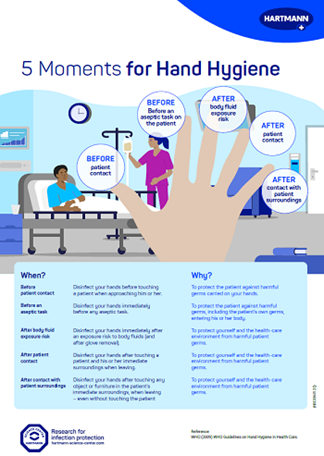
Jointly with US-American colleagues and based on the long experience of the University Hospital Geneva with national hand hygiene programmes, Swiss scientists developed the "My 5 Moments for Hand Hygiene" concept [1]. The user-oriented concept for improving compliance is an essential element in WHO's final Hand Hygiene guideline issued in 2009 [2].
"My 5 Moments for Hand Hygiene" simplifies the indications and situation descriptions detailed in the WHO recommendations on hand hygiene (see box) and summarizes them in 5 central risk situations for pathogen transmission [2]. Thus, the indications are easier to remember. Additionally, it symmetries (5 moments = 5 fingers of one hand) facilitate learning of the indications.
Basic principles of the "My 5 Moments concept"
Starting point
The concept is based on the knowledge of the essential pathogen sources
- Colonised or infected patients are the primary source of pathogens occurring in the facility.
- The extended environmentis colonized with a variety of pathogens and is another possible source of transmission.
- The patient´s immediate surrounding is colonized by pathogens from the patient´s flora
Identify the two critical zones
- Patient zone
This zone comprises the patient including her/his intact skin and the immediate surroundings including all inanimate surfaces, e.g., bed frames, bedside tables, bed linen, infusion sets which may be touched during patient contact. This also includes surfaces frequently touched by caregivers, for example monitor controls. - Healthcare zone
This zone comprises all objects/persons outside the patient zone, e.g., other patients and their zones as well as the entire environment of the inpatient facility.
Identify the most important situations in which hand disinfection shall prevent the transmission of pathogens: The 5 Moments for Hand Hygiene
- BEFORE patient contact
- BEFORE aseptic activities
- AFTER contact with potentially infectious materials
- AFTER patient contact
- AFTER contact with the immediate patient environment




